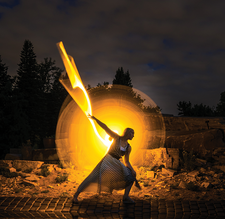Programmable light stick with the Raspberry Pi Pico
Painting with Light

© Photo by Xuan Nguyen on Unsplash
In the photographic method of light painting, you expose a subject over an extended period of time while moving the light sources. With a little technical support from a Raspberry Pi Pico, you can achieve sophisticated results.
Without light, nothing can be seen in photography, but with just a little background light and light brushes, you can create interesting motifs. For long exposures, you need a camera with manual adjustment and a tripod. A flashlight or laser pointer is sufficient to paint simple patterns or lettering into an on-going exposure. If you like to experiment, you might want to work with LEDs to achieve particularly interesting light graphics.
I was interested in a creative approach and in trying out what can be achieved with modern pixel elements and clever programming. The idea of a light stick for light painting was born. In this article, I use a Raspberry Pi Pico to build a MicroPython programmable LED light stick.
The control does not require much in the line of interfaces, and the hardware needs to be as compact as possible – a good fit for the Pico, which is the youngest member in the Raspberry Pi family and has already seen a huge amount of interest in the last months, with some interesting HATs to match. The large community proves to be a boon if you are looking for help. Currently the smallest Raspberry Pi model, the Pico comes with an RP2040 microcontroller chip and an ARM Cortex M0+ processor, offering a state-of-the-art alternative to comparable controllers. It can run C/C++ and performs well with MicroPython.
[...]
Buy this article as PDF
(incl. VAT)
Buy Linux Magazine
Subscribe to our Linux Newsletters
Find Linux and Open Source Jobs
Subscribe to our ADMIN Newsletters
Support Our Work
Linux Magazine content is made possible with support from readers like you. Please consider contributing when you’ve found an article to be beneficial.

News
-
Parrot OS Switches to KDE Plasma Desktop
Yet another distro is making the move to the KDE Plasma desktop.
-
TUXEDO Announces Gemini 17
TUXEDO Computers has released the fourth generation of its Gemini laptop with plenty of updates.
-
Two New Distros Adopt Enlightenment
MX Moksha and AV Linux 25 join ranks with Bodhi Linux and embrace the Enlightenment desktop.
-
Solus Linux 4.8 Removes Python 2
Solus Linux 4.8 has been released with the latest Linux kernel, updated desktops, and a key removal.
-
Zorin OS 18 Hits over a Million Downloads
If you doubt Linux isn't gaining popularity, you only have to look at Zorin OS's download numbers.
-
TUXEDO Computers Scraps Snapdragon X1E-Based Laptop
Due to issues with a Snapdragon CPU, TUXEDO Computers has cancelled its plans to release a laptop based on this elite hardware.
-
Debian Unleashes Debian Libre Live
Debian Libre Live keeps your machine free of proprietary software.
-
Valve Announces Pending Release of Steam Machine
Shout it to the heavens: Steam Machine, powered by Linux, is set to arrive in 2026.
-
Happy Birthday, ADMIN Magazine!
ADMIN is celebrating its 15th anniversary with issue #90.
-
Another Linux Malware Discovered
Russian hackers use Hyper-V to hide malware within Linux virtual machines.

